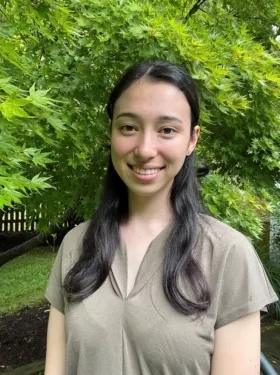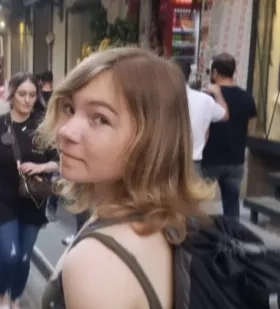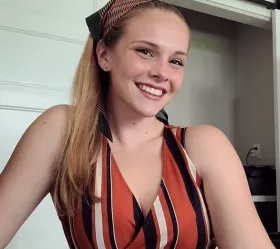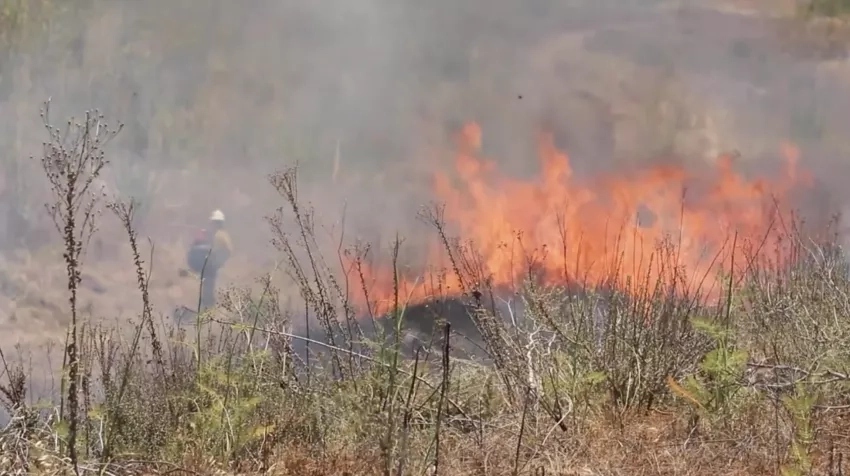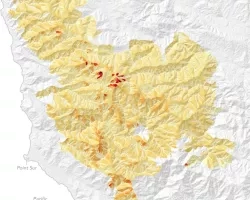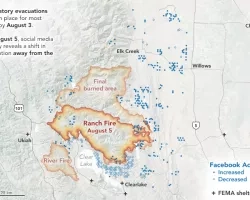In the summer of 2022, five interns honed their skills and kindled their passion for fires while interning with the Wildland Fires program area. Hailing from around the country, each intern worked independently and as part of a team to identify and solve challenges, conduct research and help build the new NASA Wildland FireSense initiative. Get to know the interns and learn more about what they’ve been working on below.
Madeline Duhnoski
Hometown: Jacksonville, Florida
Studying: Senior in Earth sciences and geography at Dartmouth College
Hobbies: Bouldering and swimming
What’s next for Madeline: When she returns to Dartmouth, she is looking forward to writing her thesis, leading the Trips outdoor orientation program for incoming first-year students, and enjoying the beautiful New England fall.
What have you been working on during your internship?
I’ve spent my internship developing the Actionable Fire Science Information Hub (AFSI Hub), along with the rest of the FireSense team. Specifically, I’ve been writing articles, developing infrastructure for stakeholder communications, and gathering feedback from community members about what they’d most like to see on the hub. I’m also working on an independent research project that focuses on the intersection between fire science and fluvial science.
What accomplishment are you most proud of from your work with NASA?
I’m most proud of my work at the ESRI Users Conference in San Diego. I helped run the AFSI hub booth in the Expo center. I spent a lot of time talking with industry professionals about the work our team is doing on the hub. I gathered information about what features people would like to see on the website we’re building. This input will help the hub to be as successful and helpful as possible.
What’s the coolest thing you’ve learned in your role?
David Green, my mentor and the program manager of the Wildland Fires program area taught me to think about science problems in intersectional and fluid ways. I learned that by widening the perspective with which we look at a problem, we will find more — and new — ways to solve a problem.
Maya Saidel
Hometown: North Potomac, Maryland
Studying: Sophomore in environmental studies at Macalester College
Hobbies: Reading, playing bass guitar, and spending time with her cat, Sora (which means Sky in Japanese)
What’s next for Maya: She’s hoping to finish a large stack of books by the end of the summer. At school, Maya looks forward to implementing the lessons and skills she’s learned at NASA and creating new opportunities to continue her research on wildfires.
What have you been working on during your internship?
I have been helping the Wildland FireSense team begin to connect with Indigenous communities whose ways of life are inextricably tied to wildland fires. For centuries, Indigenous tribes across the United States have developed deep understandings of fire’s ecological role on their lands. I have helped identify barriers Indigenous communities face in accessing NASA’s Earth observation resources. Once we recognize these barriers, we can consider how to address them to better serve them.
What accomplishment are you most proud of from your work with NASA?
I am most proud of how much I’ve learned during my time as an intern. This internship was my first real foray into the world of wildland fire management. Although I quickly learned that it is incredibly complex, I discovered that I am passionate about ethnoecology and cultural resource management. This internship has allowed me to explore my curiosities and turn them into passions.
What’s the coolest thing you’ve learned in your role?
Science is as much about people as it is about data. In the context of managing wildland fires, it has become increasingly difficult to tease apart the human side of the situation from environmental factors. We often can’t begin to understand what the science means unless we also evaluate how it is tied to the humans who are interpreting it and are impacted by it.
Katrina Sharonin
Hometown: Belmont, California
Studying: Sophomore in electrical engineering and computer science at University of California, Berkeley
Hobbies: Rock climbing, hiking, backpacking, and designing mascots for local fire stations
What’s next for Katrina: After this summer she hopes to continue the projects she started with NASA and continue working with the Berkeley Fire Research Lab.
What have you been working on during your internship?
I’ve been focusing on two main projects. The first is a programming project focused on creating fire perimeters from active hotspot detections from satellites. Using an alpha shape algorithm, I formed rough perimeters and then compared the shape with official perimeters to determine the accuracy.
The second is an intense literature review focusing on the emerging rate of fire spread computational models. My goal is to identify the main barriers researchers face regarding the quantity and quality of data for model development. I identified several key issues like the lack of data on firefighter suppression activity, missing fire perimeters in federal and state datasets and limited incident meteorological data.
What accomplishment are you most proud of from your work with NASA?
I’m most proud of my work on the fire perimeter programming project, specifically how I incorporated agency infrared detection data from aircraft missions to determine remote-sensing accuracy. Agencies like CAL FIRE use national infrared operations flight missions to extract detailed information on active fire fronts and conditions in order to help determine the perimeter. I wanted to understand how well NASA technology performed compared with other tools, so I found a way to bring infrared data into the same environment as the satellite detection fire perimeter formations. Having the two side by side allows for a detailed look at daily isolated heat sources, scattered heat regions and intense heat regions. I’m excited to use this environment to understand how tools like VIIRS can aid infrared flight detections.
What’s the coolest thing you’ve learned in your role?
Learning about the various kinds of active fire tools NASA has been fantastic. When I first started, I felt overwhelmed by the amount of information, as I didn’t know much about NASA’s involvement in wildland fires. It is a huge agency with so many projects and people. Working on my projects helped me to discover amazing NASA tools like FIRMS, VIIRS, GOES, ECOSTRESS, and others. Each has unique sensing capabilities and products, and I have become so excited by the amount of information NASA captures on wildland fires. Each product helps us to advance knowledge on pre-fire, active fire, and post-fire science.
Jenessa Stemke
Hometown: Napa, California
Studying: Senior in nutrition at Oregon State University. Jenessa also holds a B.S. in Plant Biology and M.S. in Environmental Science from UC Riverside.
Hobbies: Jenessa teaches watercolor painting with plant pigments and leads educational hikes as an outdoor guide.
What’s next for Jenessa: Upon graduating, she plans to remain heavily involved in fire science, and offer nutrition counseling on a part-time basis. She hopes to someday teach remote sensing and a fire GIS class.
What have you been working on during your internship?
I am documenting needs, barriers and data gaps in the fire community and working to identify possible solutions. I’m focusing on how different factors interact to increase fire severity and frequency, fire impacts and fire monitoring and response resources.
I have been observing how fire information is communicated to the public and how the public perceives fire for several years. I believe that public awareness of fire science is critical to forming a healthier relationship with fire and our landscapes. To address this need, I’m creating interactive visuals that summarize my findings on fire severity that will be easy for the public to understand. These visuals also emphasize possible solutions.
What accomplishment are you most proud of from your work with NASA?
In addition to working with the FireSense team, I was selected to serve as an enrichment coordinator for Science Mission Directorate (SMD). My role is to facilitate weekly meetings with topics of interest to the interns in SMD. I noticed that at other virtual events, many interns asked questions about “space junk,” or orbital debris. In response, I organized a panel discussion on the topic. Due to the strong interest, we expanded the invitation list to include all NAS interns instead of just SMD interns. We had nearly 200 attendees! The questions from the audience were fantastic, and I supplemented them with some I had prepared. The opportunity to chat with experts in orbital debris and host a panel discussion for such a large audience was a highlight from my internship thus far.
What’s the coolest thing you’ve learned in your role?
I learned that beavers can have a significant impact on fire behavior. They thin forests, providing an ongoing landscape turnover. Forests that are too thick can experience severe fires, in part because fires spread more easily from tree to tree and the fires have more fuel to burn so they reach hotter temperatures. Beaver dams also increase soil moisture by raising the water table near their ponds. This can act as a fire break as vegetation near beaver ponds are higher in moisture and less likely to burn. The beaver ponds also serve as a refuge for wildlife as a wildfire passes. Satellite data from lidar can quantify the benefits that beavers provide to the landscape with respect to fire ecology.
Paige Wirth
Hometown: Madison, Wisconsin
Studying: Senior in environmental geoscience with a minor in GIS (geographic information systems) at Texas A&M
Hobbies: Outdoor activities, especially rock climbing, backpacking, camping, and snowboarding
What’s next for Paige: After graduation, Paige plans to hike the Appalachian Trail, and is hoping to pursue a graduate degree.
What have you been working on during your internship?
I’ve been working on a few different projects. My theme has been fire-ecosystem interactions and the reintroduction of fire to the landscape. After years of fire suppression, there is a lot of catching up to do when it comes to fire being used as a tool in ecosystem restoration and preservation. Although a lot of public land managers are consistently doing controlled burns, private land is not always taken care of to the same degree. My main project is creating a toolkit for private landowners to better understand the process of controlled burning and give them the resources available in their area to go out and conduct burns when their land requires it.
What accomplishment are you most proud of from your work with NASA?
The thing I have been most proud of so far has been developing my communication skills. Before the COVID-19 pandemic, I really enjoyed public speaking, leadership, and networking. During and after the height of the pandemic, I felt that spending so much time alone made communication much harder. During this internship, I have been consistently spending time with and talking to people who are successful in the world of fire science, and it has allowed me to develop my own communication skills. Being offered an internship with NASA was amazing, but I dealt with a bit of imposter syndrome in the beginning. I have surprised myself by improving my ability to keep up and by how much I enjoy the networking opportunities and the ability to reach out to people who I look up to. It has built my confidence a lot.
What’s the coolest thing you’ve learned in your role?
I’ve learned so much from the rest of my intern team. We all come from different subsections of fire science. It has been awesome to hear about their research and projects. It has given me a more holistic view of fire. I’ve learned about the different technologies used in fire science, about the state of communication in fire science and about the ways fire affects people globally. Throughout college I’ve been focusing on fire from an ecological standpoint without giving much thought to these other aspects. I have learned to look more at the big picture and take all these different parts of fire science into account when working on my own projects.
..

